Wayne State University
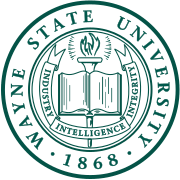 | |
| Motto | "Industry, Intelligence, Integrity" |
|---|---|
| Type | Public university |
| Established | 1868 |
Academic affiliations | Universities Research Association, University Research Corridor, Great Cities' Universities, Coalition of Urban Serving Universities, Association of Public and Land-grant Universities |
| Endowment | $383 million (as of September 2018)[1] |
| President | M. Roy Wilson |
| Provost | Keith E. Whitfield |
Academic staff | 2,688 |
| Students | 27,298 [2] |
| Location | Detroit, Michigan, United States |
| Campus | 203 acres (0.82 km2), Urban |
| Colors |
Green and Gold[3] |
| Nickname | Warriors |
Sporting affiliations | NCAA Division II – GLIAC |
| Mascot | "W" the Warrior |
| Website |
wayne |
 | |
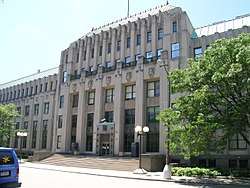
Wayne State University (WSU) is a public research university located in Detroit, Michigan. Founded in 1868, WSU consists of 13 schools and colleges offering nearly 350 programs to more than 27,000 graduate and undergraduate students. Wayne State University is Michigan's third-largest university, one of the 100 largest universities in the United States, and ranked in the top 50 American public universities for research expenditures.
The WSU main campus encompasses 203 acres linking more than 100 education and research buildings in the heart of Detroit.
The Wayne State Warriors compete in the NCAA Division II Great Lakes Intercollegiate Athletic Conference (GLIAC).
Historical background

The first component of the modern Wayne State University was established in 1868 as the Detroit College of Medicine. In 1885, the Detroit College of Medicine merged with its competitor, the Michigan College of Medicine and its consolidated buildings. In 1913 the school was restructured as the Detroit College of Medicine and Surgery, passing under that name into the control of the Detroit Board of Education. These institutions are incarnated today as the Wayne State University School of Medicine.
In 1881, the Detroit Normal Training School for Teachers was established by the Detroit Board of Education. In 1920, after several re-locations to larger quarters, the school became the Detroit Teachers College. The Board of Education voted in 1924 to make the College a part of the new College of the City of Detroit. This eventually became the Wayne State University College of Education.
In 1917, the Detroit Board of Education founded the Detroit Junior College and would make Detroit Central High School's Old Main Hall its campus. Detroit's College of Pharmacy and the Detroit Teachers College were added to the campus in 1924, and were organized into the College of the City of Detroit. The original junior college became the College of Liberal Arts. The first bachelor's degrees were awarded in 1925. The College of Liberal Arts of the College of the City of Detroit, is today the Wayne State University College of Liberal Arts and Sciences.
Recognizing the need for a good public law school, a group of lawyers, including Allan Campbell, the school's founding dean, established Detroit City Law School in 1927 as part of the College of the City of Detroit. Originally structured as a part-time, evening program, the school graduated its first class with the bachelor of laws degree (LL.B.) in 1928 and achieved full American Bar Association in 1939. The school is known today as Wayne State University Law School.
In 1933, the Detroit Board of Education voted to unify the colleges it ran into one university. In January 1934, that institution was officially named Wayne University, taking its name from Wayne County in which the University and the City of Detroit reside, as well as Major General "Mad" Anthony Wayne.
Continuing to grow, Wayne University added its School of Social Work in 1935, and the School of Business Administration in 1946.
Wayne University was renamed Wayne State University in 1956 and the institution became a constitutionally mandated university by a popularly adopted amendment to the Michigan Constitution in 1959.
The Wayne State University Board of Governors created the Institute of Gerontology in 1965 in response to a State of Michigan mandate. The primary mission in that era was to engage in research, education, and service in the field of aging.
Wayne State University grew again in 1973 with the addition of the College of Lifelong Learning. In 1985, the School of Fine and the Performing Arts, and the College of Urban, Labor, and Metropolitan Affairs grew the university further.
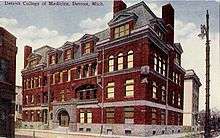
In the 2000s, WSU has been aggressive in constructing new buildings, including the Integrative Biosciences Center (IBio), a 207,000-square-foot facility fir interdisciplinary work in the biosciences. More than 500 researchers, staff and principal investigators work out of the building, which opened in 2016.[4]
On June 5, 2013, the Board of Governors unanimously elected M. Roy Wilson as Wayne State's 12th president. He was sworn in on August 1, 2013.
In 2015, WSU bestowed its first posthumous honorary doctorate degree on Viola Liuzzo.[5]
In 2015, the School of Business administration was renamed the Mike Ilitch School of Business. The name was changed in recognition of a $40 million grant from Mike and Marian Ilitch. This gift was used towards building a new business school facility in Detroit, which opened in late August 2018[6].[7] The new Mike Ilitch School of Business building is located on Woodward in the emerging 'District Detroit' development.[8]
Academic profile
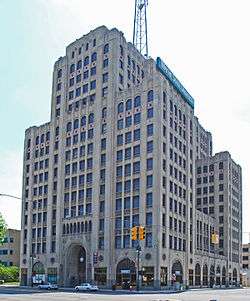
Wayne State's comprehensive academic offerings are divided among 13 schools and colleges: the Mike Ilitch School of Business; the College of Education; the College of Engineering; the College of Fine, Performing, and Communication Arts; the Graduate School; the Law School; the College of Liberal Arts and Sciences; the School of Information Sciences; the School of Medicine; the College of Nursing; the Eugene Applebaum College of Pharmacy and Health Sciences; the Irvin D. Reid Honors College; and the School of Social Work.[9] Fall 2016 enrollment for the university consisted of 17,280 undergraduates, 8,014 graduate students and 2,004 professional school students adding up to 27,298 students, up from 27,222 students in 2015.[10]
Wayne State University is Michigan's only urban research university and is renowned particularly for its contributions in the sciences. Wayne State University is classified as a research university with the highest research activity by the Carnegie Foundation.[11]
Under the Michigan Constitution, the boards of governors of WSU (as with the University of Michigan and Michigan State University) are elected by the citizens of Michigan statewide.
Wayne State University, Michigan State University, and the University of Michigan are the three institutional members of the State of Michigan's University Research Corridor.
Colleges and schools
Wayne State offers more than 380 undergraduate, post-graduate, specialist and certificate programs in 13 schools and colleges.[12]
- Mike Ilitch School of Business
The Mike Ilitch School of Business offers undergraduate degrees in accounting, finance, global supply chain, information systems, management and marketing. At the graduate level, it offers M.B.A. and M.S. degrees in accounting and taxation, and a Ph.D. with tracks in finance, management and marketing. These programs are fully accredited by The Association to Advance Collegiate Schools of Business (AACSB).[13]
- College of Education
Established in 1933, College of Engineering faculty generate approximately $20 million annually in research expenditures, particularly in areas of biomedical engineering and computing; advanced materials and flexible manufacturing; and green technologies such as alternative energy technology, alternative energy, and advanced battery storage. The college offers a range of engineering disciplines, including prominent several research areas in which faculty members focus on interdisciplinary teamwork and industry partnerships — alternative energy technology, automotive engineering, electric-drive vehicle engineering, environmental infrastructures and transportation engineering, materials and biomedical engineering, bioinformatics and computational biology, nanotechnology and sustainable engineering.
- Irvin D. Reid Honors College
The Irvin D. Reid Honors College was founded in 2008 and named in honor of Irvin D. Reid who served as the university's president between 1997 and 2009. The college's 2,183 undergraduate students are selected on the basis of academic performance. In addition to general education courses and courses in their majors, students in the Honors College enroll together in additional coursework which emphasizes academic skills and civic engagement.
The College of Liberal Arts and Sciences (CLAS) was formed in 2004 with the merger of the College of Liberal Arts and the College of Science. The college receives approximately $20 million a year in external grants and contracts. CLAS consists of 19 departments: Humanities, Social Sciences, Physical Sciences and Mathematics, and Life Sciences categories. Programs include African American Studies, Anthropology, Biological Sciences, Chemistry, Classical and Modern Languages, Literatures and Cultures (CMLLC), Communication Sciences and Disorders (CSD), Criminal Justice, Economics, English, Geology, History, Mathematics, Nutrition & Food Science, Philosophy, Physics and Astronomy, Political Science, Psychology, Sociology, and Urban Studies & Planning.
- School of Information Sciences
The American Library Association first accredited the master of Library and Information Science (MLIS) degree in 1967, and continued accreditation[14] in 2016. The MLIS degree is available online with select classes also offered on campus. In September 2017, the School became a member of the iSchool Consortium,[15] and added a master of science in information management (MSIM) degree to be offered beginning Winter 2018 semester.
Founded in 1868, the Wayne State University School of Medicine (SOM) trains the next generation of physicians, the school offers master's, Ph.D. and M.D./Ph.D. programs in 14 areas of basic science and public health to about 400 students annually. The school's research emphasizes neurosciences, pediatrics, obstetrics and gynecology, perinatology, cancer, cardiovascular disease including diabetes and obesity, and psychiatry and addiction research. Research funding levels in 2014, including all grants and contracts from government agencies, private organizations and pharmaceutical companies, was $94.5 million. One of the school's major assets is the Richard J. Mazurek, M.D., Medical Education Commons, which was designed specifically for students and houses classrooms, student services divisions, the medical library, a sophisticated patient simulation center and the Kado Family Clinical Skills Center.[16]
- College of Nursing
Established in 1924, the Eugene Applebaum College of Pharmacy and Health Sciences is one of the founding colleges of Wayne State University. It is organized into four departments — fundamental and applied sciences, health care sciences, pharmacy practice and pharmaceutical sciences. It offers 11 fully accredited degree-granting programs,which maintain autonomous admission requirements, curricula, degree requirements and academic procedures.
Established in 1935, the school offers academic programs at the bachelor's, master's and Ph.D. levels. The school's Center for Social Work Research provides support for faculty research and scholarship, engages in relevant research with community partners, and offers consultation and technical assistance. In 2014-15, faculty submitted proposals valued at over $10 million, including an $113,400 annual grant from the Michigan Department of Health and Human Services for the Transition to Independence Program (TIP), a comprehensive support program for foster care youth enrolled at Wayne State University.[17]
Academics and rankings
| University rankings | |
|---|---|
| National | |
| Forbes[18] | 621 |
| Times/WSJ[19] | 301 |
| U.S. News & World Report[20] | 223 |
| Washington Monthly[21] | 268 |
| Global | |
| ARWU[22] | 301–400 |
| QS[23] | 439 |
| Times[24] | 351–400 |
| U.S. News & World Report[25] | 310 |
Several of Wayne State's individual programs are well regarded:
- The Department of Chemistry[26] was recently ranked 71st in the United States (tied with Dartmouth College, Case Western Reserve University, and the University of Kansas)[27] and among the top 150 chemistry departments in the world.[28]
- U.S. News and World Report ranks Wayne State's Law School as a Top 100 law school, and the second-highest ranked law school in Michigan[29]
- U.S. News and World Report also ranks the College of Nursing as one of the top nursing program's in the country[30]
- The Eugene Applebaum College of Pharmacy and Health Sciences was ranked one of the 50 best pharmacy schools in the country by Pharmacy Times[31]
- The Department of Industrial and System Engineering was ranked 42nd in the country by U.S. News Grad School Ranking in 2015.
- The Department of Physics and Astronomy,[32] The Department of Mathematics, are all ranked among top 200 in the world.[33]
- The School of Social Work has been ranked 38th in social work in the U.S. News Grad School Health Programs Rankings.[34]
- Wayne State University is listed as one of the top 34 percent of global universities by U.S. News and World Report[35]
- The Irvin D. Reid Honors college named in honor of the university's ninth president, affords students the opportunity to become immersed in the Detroit community, participate in service learning and perform meaningful undergraduate research.
- The Mike Ilitch School of Business is annually listed as an outstanding business school, according to The Princeton Review, which ranks the top Master of Business Administration (MBA) programs.[36]
- The medical school is ranked #69 by U.S. News & World Report in the nation for research.[16]
Student body
| Race/Ethnicity | Undergraduate | Graduate | Professional | Total |
|---|---|---|---|---|
| Asian | 1,508 | 305 | 302 | 2,115 |
| Black or African American | 2,978 | 1,113 | 97 | 4,188 |
| Hispanic | 889 | 223 | 42 | 1,154 |
| Other | 676 | 219 | 42 | 937 |
| International | 487 | 1,804 | 116 | 2,407 |
| Race and ethnicity unknown | 678 | 157 | 226 | 1,061 |
| White | 10,064 | 4,193 | 1,179 | 15,436 |
In fall 2016, Wayne State had a total of 27,298 students at the campus: 17,280 undergraduate students, 8,014 graduate students and 2,004 professional students.[10] Wayne State had students from nearly every U.S. state and 79 countries enrolled in fall 2016.[37]
During the 2016 school year, there were 6,085 degrees and certificates granted to students: 3,072 bachelor's degrees, 2,068 master's degrees, 767 doctoral and professional degrees, and 178 certificates.
Research
At $213.8 million spent annually on research expenditures, Wayne State ranks among the nation's top universities for research according to the National Science Foundation. Additionally, Wayne State has received the Carnegie Foundation's ranking as a doctoral-granting university with the highest research activity.
On October 13, 2015, Wayne State University opened its new $92 million, 207,000-square-foot Integrative Biosciences Center (IBio). As many as 500 researchers, and staff will work out of the IBio Center located in New Center at 6135 Woodward Avenue.[38][39]
Financials
Wayne State University's cost of attendance is composed of tuition, including a credit hour rate, student service credit hour fee, fitness center maintenance fee, and a registration fee. Class maintenance fees are applied on a course-to-course basis. The tuition varies depending on undergraduate (lower and upper level division) and graduate students. Although graduate programs, Law School and Medical School tuition differs. Additionally, these two categories can be further broken down into two more subcategories of out-of-state students and resident students.
The tuition cost is estimated based on a 12-credit semester, including both fall and winter semesters. The preceding values are calculated based off Wayne State tuition as well as the costs of books, transportation, living costs, loan fees and other miscellaneous cost. The total estimated tuition cost for a Michigan resident who is living off campus is roughly $17,384. Living on campus brings the cost to about $22,000. If the same scenarios are applied to non-Michigan residents (out of state), the tuition significantly increases. For a non-resident student living on campus, the cost is approximately $33,000.
In the second category, the tuition costs for graduate students can be examined. Graduate students who are residents of Michigan and off campus will have an estimated tuition of $19,144. Resident graduates who are living away from home can plan on having tuition costs of $24,383. For graduate students who are non-Michigan residents, tuition is approximately $35,394.
In the 2015 academic year, the university awarded $338 million in financial aid. Even while WSU maintains its status as one of only three universities in the state ranked in the top research category of the Carnegie Foundation for the Advancement of Teaching, tuition at Wayne State remains among the lowest of Michigan's 15 public universities, and the lowest among Michigan's three research universities.
Campus
Wayne State's main campus in Detroit encompasses 203 acres (0.82 km2) of landscaped walkways and gathering spots linking over 100 education and research buildings.[40] The campus is urban and features many architecturally interesting buildings. Notable examples include the Helen L. DeRoy Auditorium, the Education Building, the Maccabees Building, Old Main, McGregor Memorial Conference Center, Chatsworth Tower Apartments, and the Hilberry Theatre. Many of these buildings were designed by notable architects such as Albert Kahn and Minoru Yamasaki.
Wayne State University is located at the heart of Detroit's Cultural Center Historic District and amongst many notable Detroit institutions and attractions, including the Detroit Institute of Arts, the Detroit Historical Museum, the Michigan Science Center, the Charles H. Wright Museum of African American History, the Detroit Opera House/Michigan Opera Theatre, Detroit Symphony Orchestra/Orchestra Hall, Comerica Park, Ford Field, Little Caesars Arena, the Fox Theatre, the Fisher Theatre, Grand Circus Park, and Campus Martius Park.
The Cass Corridor is one of the university's other notable surroundings, with a venerable history and culture that has left an imprint on many WSU alumni. Many notable events have taken place on or near the campus as a result of its unique location. Artists that got their start here include Chuck & Joni Mitchell, Alice Cooper, The White Stripes, The Detroit Cobras, MC5, The Stooges, Savage Grace, Ted Nugent and Grand Funk Railroad. The Red Hot Chili Peppers recorded their Freaky Styley album in this area, which was also home to Creem magazine — the first rock journal, and the first to use the terms "punk rock" and "heavy metal" and give recognition to the likes of David Bowie, Iggy Pop, The Smiths and others. The now-razed Tartar Field was home to WABX's free Sunday concerts in the late 1960s and early 1970s featuring many of these musicians.
Important events have also taken place on campus, such as Edmund Gettier's refutation of the "justified true belief" theory, which shook 2,500 years of epistemology.
Beginning in the 1970s WSU held its criminal justice program classes in the 147,500-square-foot (13,700 m2) Criminal Justice Building, designed by Albert Kahn and built in 1920 in New Center. By 2016 the university stopped use of the building, then used by the Detroit Police Department for training purposes. WSU sold it to real estate firm The Platform for $2,000,000 and it will become a mixed-use development.[41]
Libraries
With more than four million volumes,[42] the Wayne State University Library System houses the 75th largest collection in the United States, according to the American Library Association.[43] The system ranks among the nation's top libraries according to the Association for Research Libraries.[44]
- The Vera P. Shiffman Medical Library, located at Wayne State's medical campus, houses the university's medical and health collections and is the primary library for the School of Medicine and the Eugene Applebaum College of Pharmacy and Health Sciences.
- The Arthur Neef Law Library, located on the north section of the main campus adjacent to the Wayne State University Law School, houses the university's law collections and is the Law School's primary library. Its collection of over 620,000 volumes makes it the second largest law library in Michigan. The library subscribes to over 1,500 journals and 1,000 loose-leaf services.
- The Purdy/Kresge Library, located near the center of main campus, serves as the primary research library for the School of Information Sciences. It contains print and electronic resources to meet the research and instructional needs of faculty, graduate students, and upper-level undergraduates. It also houses the university's main government documents collection and the offices of the university's Media Services Department.[45]
- The David Adamany Undergraduate Library (UGL), located at the center of Gullen Mall, has over 700 computer workstations providing students with access to electronic resources. Its book and magazine collection is intended to support the learning needs of 1,000 and 2,000 level undergraduate courses. The UGL houses the university libraries' collection of approximately 8,000 videos, DVDs, laser discs and audiotapes. The UGL provides students with information on careers, computers and student survival skills. The Undergraduate Library is open 24 hours for both students and faculty.[46]
- The Walter P. Reuther Library, Archives of Labor and Urban Affairs, located on the easternmost portion of main campus at 5401 Cass Avenue, is the largest labor archives in North America and serves as the official archival repository for twelve major unions. In addition to labor records, the archives contain primary source material related to civil and political rights, especially those related to Detroit. The Reuther also houses the Wayne State University Archives dating from the institution's founding as the Detroit Medical College in 1868.[47]
Housing
The university provides housing for all students in the form of apartments and residence halls. All buildings are equipped with connection to the university computer system, wireless Internet, laundry rooms, activity rooms, and a 24-hour help desk.[48]
Current Housing
Current university-owned apartment buildings consist University Tower, Chatsworth Tower and Helen L. DeRoy Apartments. In the hopes of bringing more residents to campus, Wayne State opened two dormitory-style residence halls in 2002: Yousif B. Ghafari Hall (formerly North Hall) and 2003 Leon H. Atchison Hall (formerly South Hall). This was the first time since the closing of the Newberry Joy Dorms in 1987 that the university offered dorm living. In 2005, the university opened The Towers Residential Suites, a residence hall open to undergraduate and graduate students. The Towers Café located in The Towers Residential Suites is the largest on-campus dining facility serving a variety of food. The Gold'N'Greens Café located in Ghafari Hall serves vegetarian, vegan, and kosher food.[49][50]
List
- Ghafari and Atchison Halls provide housing for freshmen and upper students only. Halls feature double-occupancy rooms, fully furnished with private baths. Study rooms and social lounges, all equipped with wireless high-speed Internet, are found on each floor. These halls also include special interest communities such as Honors, Community of Scholars, 24 hour quiet floor, and an all-female floor. These two buildings connect on the first floor through a dining hall. Gold "n" Greens is an all vegetarian cafeteria that is also certified kosher dairy, with gluten and vegan options.[51][52]
- The Towers Residential Suites, serving all students, is an 11-story tower with views as far as the Ambassador Bridge. The majority of rooms are suite style, containing four bedrooms attached to a shared living space. There are also studio rooms available. There are special interest floors throughout the building including, Honors, International, Graduate, 21 and up, and 24-hour quiet floors. This building also has study rooms and kitchenettes available for student use. Within the building is a café-style dining hall, Towers Café, and multiple fitness rooms.[53] Also included in the building are many eateries, a pharmacy, post office, and a salon.
- Chatsworth Tower Apartments are available to graduate students, professional students and students with families, and located inside a nine-story historic landmark built in 1929. This structure features large studio, one-bedroom, and two-bedroom apartments with ornate woodwork.[54]
- Helen L. DeRoy Apartments is a 15-story building built in 1972. The apartments contain a total of 258 studio, one- and two-bedroom units offering residence to graduate students, professional students, undergraduate students, and students with families. Units are equipped with wireless Internet access, cable television access, central air, a refrigerator and stove. The top four floors of DeRoy apartments are furnished undergraduate apartments. These apartments come equipped with basic furniture, similar to the residential halls, but in an apartment style space.[55]
- The 300-unit University Tower complex opened in 1995 and offers one-, two-, and three-bedroom apartments, as well as family units to juniors, seniors, graduates and professional students. Each apartment is wired for access to the university's computer network. The first floor offers wireless Internet access, a study lounge, large laundry facility and a childcare center. Wayne State's WDET radio station is also located on the first floor.[56]
- In 2016, the university renovated The Thompson Home, formerly the home of the School of Social Work, into new residential units for students in the College of Fine, Performing and Communication Arts.[57]
- In 2017, Wayne State broke ground on the Anthony Wayne Drive Apartments. The first phase of the Anthony Wayne Drive Apartments open in August 2018. The first phase is the center 11-story building with room for nearly 400 residents. The second phase will open in June 2019. The second phase consists of the two wings north and south of the central tower that are 6 stories and the 8 stories that add room for an additional 400 resident[58]
The university allows families with children to live in some units including Chatsworth Tower, DeRoy and University Tower.[59] Residents are zoned to Detroit Public Schools.[60] Zoned schools for all three apartments include DPS Foundation for Early Learners @ Edmonson (K-8),[61][62] and King High School (9-12).[63]
Former Housing
Sherbrooke Apartments were closed in September 2008. The Forest Apartments were closed after the 2004-05 school year and have since been demolished. The Chatsworth Annex apartments were demolished and replaced with greenspace and volleyball courts after the 2004-05 school year.
Tom Adams Field
Tom Adams Field, best known as Adams Field, is a 6,000-seat football stadium located on the campus. It is primarily used for Wayne State Warriors football of the Great Lakes Intercollegiate Athletic Conference, a Division II conference of the National Collegiate Athletic Association.
The Field was named after Thomas B. Adams, a 1944 graduate and football and track athlete who later served on as a board member at WSU. Due to his athletic, military, and business achievements the Wayne State Football field was named in honor of him on October 11, 2003.[64] The stadium turf has been replaced several times. The most recent replacement was in May 2015 when FieldTurfRevolution (2.5") artificial turf was installed.[65][66] A new 35-foot video board was installed in August 2015.[66] The eight lane Lowell Blanchard Track, located in the stadium, was first installed in 2006. Mondo surfacing was added to the track in 2011.[67]
Satellite campuses
Wayne State has four satellite campuses in and around the Metro Detroit area.[68] The locations are:
- Macomb Educational Center, Clinton Township
- University Center at Macomb Community College, Clinton Township
- Advanced Technology Education Center, Warren
- Schoolcraft College in Livonia
Student life
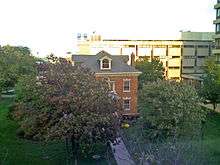
Programs abroad
Wayne State offers more than 20 study abroad programs, some as short as nine days in length with others lasting an entire year. As of 2017, students have their pick from numerous countries including Austria, Brazil, Canada, China, Czech Republic, Cuba, England, France, Germany, Italy, Japan, South Korea, New Zealand, Mexico, Poland, Russia, Spain and South Africa. Programs offer studies in art, business, computer science, education, engineering, environmental studies, health care, linguistics, the social sciences, theater and more.[69]
Media
- The official student newspaper is The South End.
- The university hosts the public radio station WDET and runs the student online radio station WAYN.
- The WSU Alumni Association publishes the Wayne State magazine.
Government
The university is governed by a Board of Governors consisting of eight members elected by Michigan voters for eight-year terms. Board of Governor members serve without compensation. The board elects a university president to serve as the chief executive officer of the university administration. The student body government is headed by a Student Senate (formerly the Student Council). Some colleges of the university have their own Student Senate, which reports back to the main Student Senate. The School of Law has its own Student Board of Governors.
Public safety
The campus is protected by the Wayne State University Department of Public Safety. There are 65 commissioned officers serving Wayne State and the surrounding area.[70] All Wayne State Police Officers are certified Michigan peace officers and sworn Detroit police officers. The department prides itself on a response time of 90 seconds or less to on-campus emergencies. The department consists of patrol officers, traffic safety officers, motorcycle officers, bike officers, three canine officers, three investigators, multiple officers assigned to task force positions, communications controllers, records personnel and other support staff. The headquarters is located at 6050 Cass Ave. The Department of Public Safety has been in existence since 1966. The department sponsors several programs throughout campus such as the RAD (Rape Aggression Defense), sells low-cost bike locks and steering wheel "clubs," offers free 'VIN Etching' sessions to help deter auto theft, and sends out monthly emails to keep the university updated on the department's activities. Students whom encounter trouble or distress on campus are encouraged to call the Wayne State Police division directly, rather than the city's 911 services. The Detroit Police Department's high-priority responses have taken upwards of an hour to arrive on scene; by comparison, the Campus Police Department's rapid response time is less than two minutes in the majority of cases, better guaranteeing the safety of Wayne State students.[71]
Wayne State University Alumni Association
Created in 1935 and consisting of more than 260,000 alumni throughout the world, Wayne's alumni association provides a strong loyalty and support system to graduates of the university through sponsoring events such as career booths and job fairs.[72][73]
Greek life
Wayne State University hosts chapters of over two dozen fraternities and sororities, reflective of the diverse nature of the campus. These groups, through social, academic, leadership and alumni networking programs, are aimed at building lifelong connections among participants and to the University. Members self-select prospective members, and chapters cooperate on a wide variety of inter-Greek programming to support campus life. Once a student becomes a member of one of the traditional social and academic societies, designated by NIC, NPC, NALFO or NPHC allegiance, they may not join another from the conference, due to 'anti-poaching' rules. However, members of the traditional social and academic fraternities, sororities and societies may also be members of professional, service and/or honor societies as they are chosen or earn the honor by grade, class rank or achievement.
Fraternities (Men's)ΑΣΦ Alpha Sigma Phi, February 12, 1938, NIC
ΠΚΑ Pi Kappa Alpha, 1950, NIC
ΣΠ Sigma Pi, 1967, NIC |
Sororities (Women's)
ΔΖ Delta Zeta, 1956, NPC
ΑΓΔ Alpha Gamma Delta, 1959, NPC
ΑΕΦ Alpha Epsilon Phi, 1988, NPC ΛΚΣ Lambda Kappa Sigma April 4, 1930, PFA, Professional Pharmacy |
National Pan-Hellenic Council (NPHC)ΔΣΘ Delta Sigma Theta, 1924, NPHC/Women
|
Co-educational professional, service or special interest Greek-letter organizations
ΑΩ Alpha Omega, Local Co-ed Christian Service Fraternity[74]
ΑΦΩ Alpha Phi Omega, May 27, 1948, PFA, Co-ed Service Fraternity
ΒΑΨ Beta Alpha Psi, Co-ed Honor Society, for Accounting, Finance and Information Systems
ΔΣΠ Delta Sigma Pi, PFA, Co-ed Professional Business
Inter-chapter cooperation is managed by several governing councils: the Multi-Cultural Greek Council, the National Pan-Hellenic Council (NPHC groups), and the Panhellenic Association (NPC groups).
Athletics

The school's intercollegiate athletic program was established in 1917 by Director of Athletics David L. Holmes. Revered by his athletes, Holmes initially coached all sports. His track teams were nationally known into the 1950s; in his first 10 years, he produced two Olympians from the school's Victorian-era gym. Although he had major ambitions for Wayne and scheduled such teams as Notre Dame and Penn State in the 1920s, the lack of facilities and money for athletics kept the program small.
A student poll selected the name of "Tartars" for the school's teams in 1927. In 1999, the university changed the name to the "Warriors," due to the general feeling that the Tartar name was dated and most people were not familiar with the name's historical significance.[75][76] Wayne State competes in men's baseball, basketball, cross country, fencing, football, golf, swimming and diving, and tennis, and women's basketball, cross country, fencing, golf, softball, swimming and diving, tennis, track and field, and volleyball.
WSU participates in NCAA Division II in the Great Lakes Intercollegiate Athletic Conference (GLIAC) for all sports except for fencing, which competes in the single division Midwest Fencing Conference.
Wayne State previously competed in men's and women's NCAA Division I ice hockey as a member of College Hockey America (CHA). The university dropped their men's program at the end of the 2007-08 season,[77] followed in 2011 by ending the women's hockey program.[78]
National Championships:
- 1975: Men's Fencing - NCAA
- 1979: Men's Fencing - NCAA
- 1980: Men's Fencing - NCAA
- 1982: Men's Fencing - NCAA
- 1982: Women's Fencing - NCAA
- 1983: Men's Fencing - NCAA
- 1984: Men's Fencing - NCAA
- 1985: Men's Fencing - NCAA
- 1988: Women's Fencing - NCAA
- 1989: Women's Fencing - NCAA
- 2012: Women's Swimming and Diving - NCAA DII
Fencing is a single-division sport with schools from all three NCAA divisions competing against each other.
Notable people
See also
References
- ↑ https://president.wayne.edu/pdfs/mrw_university_address_2018.pdf
- ↑ Wayne State University (2016). "Fast Facts". 2015-16 Fact Book: 1.
- ↑ "Identity guidelines - Marketing and Communications - Wayne State University". mac.wayne.edu. Retrieved November 22, 2017.
- ↑ Wayne State University (2015–16). "IBio revolutionizes research in Detroit". Fact Book.
- ↑ Spratling, Cassandra (March 25, 1965). "Wayne State hails civil rights icon Viola Liuzzo as hero". Freep.com. Retrieved April 11, 2015.
- ↑ "Mike Ilitch School of Business adds modernist splash to Woodward Avenue". Detroit Free Press. Retrieved 2018-09-18.
- ↑ Wayne State University (2015–16). "Ilitch family donates $40 million for business school". Fact Book.
- ↑ "Mike Ilitch School of Business adds modernist splash to Woodward Avenue". Detroit Free Press. Retrieved 2018-09-18.
- ↑ "Academic Programs". Wayne State University. 2013. Archived from the original on November 16, 2007. Retrieved February 21, 2013.
- 1 2 3 "AccessID Login - Office of Budget, Planning and Analysis". oira.wayne.edu. Retrieved July 17, 2017.
- ↑ "Carnegie Classifications - Wayne State University". Carnegie Foundation for the Advancement of Teaching. Retrieved June 2, 2016.
- ↑ United States (October 30, 2012). "Wayne State University - Key Facts". Wayne.edu. Archived from the original on February 12, 2013. Retrieved February 21, 2013.
- ↑ Communications, Wayne State University Web. "Programs - Mike Ilitch School of Business - Wayne State University". ilitchbusiness.wayne.edu. Retrieved 2018-06-17.
- ↑ "Searchable DB of ALA accredited programs | American Library Association". www.ala.org. Retrieved November 2, 2017.
- ↑ "Wayne State University School of Information Sciences | iSchools". ischools.org. Archived from the original on November 7, 2017. Retrieved November 2, 2017.
- 1 2 "How Does Wayne State University School of Medicine Rank Among America's Best Medical Schools?". grad-schools.usnews.rankingsandreviews.com. Retrieved June 29, 2016.
- ↑ "Tip Wayne Sate University". Archived from the original on March 24, 2018.
- ↑ "America's Top Colleges". Forbes. July 5, 2016.
- ↑ "U.S. College Rankings 2018". Wall Street Journal/Times Higher Education. Retrieved November 23, 2017.
- ↑ "Best Colleges 2017: National Universities Rankings". U.S. News & World Report. September 12, 2016.
- ↑ "2016 Rankings - National Universities". Washington Monthly. Retrieved September 6, 2016.
- ↑ "Academic Ranking of World Universities 2017". Shanghai Ranking Consultancy. 2017. Retrieved August 29, 2017.
- ↑ "QS World University Rankings® 2018". Quacquarelli Symonds Limited. 2017. Retrieved 25 July 2017.
- ↑ "World University Rankings 2016-17". THE Education Ltd. Retrieved September 21, 2016.
- ↑ "Best Global Universities Rankings: 2017". U.S. News & World Report LP. Retrieved October 25, 2016.
- ↑ "Department of Chemistry". Chem.wayne.edu. October 13, 2012. Retrieved December 31, 2012.
- ↑ "Best Graduate Chemistry Programs - 2014". =U.S. News and World Report. 2014. Retrieved October 6, 2017.
- ↑ "Academic Ranking of World Universities in Chemistry - 2013". =ShanghaiRanking Consultancy. 2013. Retrieved May 6, 2014.
- ↑ "Wayne State overtakes MSU, UM climbs in U.S. News Best Law Schools ranking". Crain's Detroit Business. March 16, 2016. Retrieved June 2, 2016.
- ↑ "The Best Nursing Schools in America, Ranked". grad-schools.usnews.rankingsandreviews.com. Retrieved June 2, 2016.
- ↑ "50 Best Pharmacy Schools Ranked in 2016". Pharmacy Times. Retrieved June 2, 2016.
- ↑ United States. "Wayne State University Physics and Astronomy - Physics & Astronomy". Physics.clas.wayne.edu. Retrieved December 31, 2012.
- ↑ "Academic Ranking of World Universities | ARWU | First World University Ranking". Shanghai Ranking. August 15, 2012. Retrieved December 31, 2012.
- ↑ "Wayne State University | Best Health School | US News". Grad-schools.usnews.rankingsandreviews.com. Retrieved June 2, 2016.
- ↑ "Top World University Rankings | US News Best Global Universities". www.usnews.com. Retrieved June 2, 2016.
- ↑ "School Rankings". Princeton Review. 2013. Retrieved May 6, 2014.
- ↑ "2012-13 Fact Book" (PDF). Retrieved January 21, 2014.
- ↑ "Wayne State University IBio - The Integrative Biosciences Center".
- ↑ "Wayne State dedicates new $93 million biosciences center".
- ↑ United States (June 23, 2011). "Wayne State University - About Wayne State University". Wayne.edu. Archived from the original on October 12, 2007. Retrieved December 31, 2012.
- ↑ "Wayne State board approves $2M sale of former Criminal Justice Building in Detroit's New Center". clickondetroit.com. 2016-12-02. Retrieved 2018-01-02.
- ↑ "Wayne State MLA Spotlight". Michigan Library Association. 2012. Archived from the original on April 23, 2013. Retrieved February 21, 2013.
- ↑ "The Nation's Largest Libraries: A Listing By Volumes Held". American Library Association. 2012. Retrieved February 20, 2013.
- ↑ United States (May 27, 2011). "Wayne State University - Academics & Libraries". Wayne.edu. Archived from the original on January 14, 2013. Retrieved December 31, 2012.
- ↑ "WSU Libraries: Purdy/Kresge Library Directions". Lib.wayne.edu. Retrieved December 31, 2012.
- ↑ "WSU Libraries: Undergraduate Library Directions". Lib.wayne.edu. Retrieved December 31, 2012.
- ↑ "About Us". Walter P. Reuther Library. Wayne State University. Retrieved October 17, 2014.
- ↑ University, Wayne State. "Housing & Residential Life - Wayne State University". www.housing.wayne.edu. Retrieved November 22, 2017.
- ↑ "Residence Halls - Housing - Wayne State University". housing.wayne.edu. Retrieved June 29, 2016.
- ↑ "Wayne State University to Break Ground on Anthony Wayne Drive Apartments". Retrieved July 17, 2017.
- ↑ "Ghafari Hall-Housing". Wayne State University. 2013. Retrieved February 20, 2013.
- ↑ "Atchison Hall-Housing". Wayne State University. 2013. Retrieved February 20, 2013.
- ↑ "Towers Residential Suites-Housing". Wayne State University. 2013. Retrieved February 20, 2013.
- ↑ "Chatsworth Tower-Housing". Wayne State University. 2013. Retrieved February 20, 2013.
- ↑ "Helen L. DeRoy Apartments-Housing". Wayne State University. 2013. Retrieved February 20, 2013.
- ↑ United States. "University Tower - Housing - Wayne State University". Housing.wayne.edu. Archived from the original on June 11, 2010. Retrieved December 31, 2012.
- ↑ System, WCS Content Management. "Thompson Home - Housing - Wayne State University". housing.wayne.edu. Archived from the original on July 13, 2017. Retrieved July 17, 2017.
- ↑ United States. "Anthony Wayne Drive Apartments - Housing - Wayne State University". Housing.wayne.edu. Retrieved July 5, 2018.
- ↑ "Community Living Guide Apartments 2011 Archived December 24, 2012, at the Wayback Machine.." Wayne State University. 12. Retrieved on October 2, 2011. DeRoy, University Tower, and Chatsworth Tower unfurnished apartments are approved for family housing."
- ↑ "Contact Us General Office of Housing & Residential Life." Wayne State University. Retrieved on October 2, 2011. "Chatsworth Tower 630 Merrick Detroit, MI 48202" and "Helen L. DeRoy Apartments 5200 Anthony Wayne Drive Detroit, MI 48202" and "University Tower Apartments 4500 Cass Avenue Detroit, MI 48201"
- ↑ "Elementary Boundaries - 2012/13 School Year." (Archive) Detroit Public Schools. Retrieved on November 1, 2012.
- ↑ "Middle School Boundaries - 2012/13 School Year." (Archive) Detroit Public Schools. Retrieved on November 1, 2012.
- ↑ "High School Boundaries - 2012/13 School Year." (Archive) Detroit Public Schools. Retrieved on November 1, 2012.
- ↑ http://wsuathletics.com/documents/2012/9/6/2012_FB_MG_pages114-126.pdf?id=1133, accessdate=2013-05-21, pp=124
- ↑ Tim Carroll and Alex Franzen (April 29, 2015). "WSU replacing artificial turf, project cost $415,000". The South End. Retrieved October 17, 2015.
- 1 2 "2015 Football Media Guide" (PDF). WSUAthletics.com. p. 132. Retrieved October 17, 2015.
- ↑ "Lowell Blanchard Track". Wayne State University. Retrieved October 17, 2015.
- ↑ "Wayne State University - Satellite campuses". Wayne State University. 2016. Retrieved June 2, 2016.
- ↑ System, WCS Content Management. "Study Abroad & Global Programs - Welcome". studyabroad.wayne.edu. Retrieved November 22, 2017.
- ↑ "The Wayne State Police Department" (PDF). Wayne State University. 2013. Retrieved February 7, 2014.
- ↑ Cowley, Stacy. "How Wayne State Police Helped Breathe Life Into A Blighted Detroit Strip". nytimes.com. New York Times. Retrieved March 15, 2015.
- ↑ United States (July 2, 2008). "Wayne State University - WSU Alumni Profile". Wayne.edu. Retrieved December 31, 2012.
- ↑ "Wayne State University Alumni Association". Alumni.wayne.edu. April 12, 2012. Retrieved December 31, 2012.
- ↑ Not to be confused with the Jewish professional dental society of the same name.
- ↑ "WSU adopts new athletic identity". Wayne State University Press. July 29, 1999.
- ↑ "Before and After: New Symbols for Old Schools". New York Times. August 6, 2000. Retrieved July 26, 2008.
- ↑ Wodon, Adam (March 11, 2008). "Wayne State Bids Farewell". College Hockey News. Retrieved May 30, 2011.
- ↑ "Wayne State ends women's program". NCAA. May 30, 2011. Archived from the original on October 16, 2011. Retrieved May 29, 2011.
Further reading
- Hanawalt, Leslie. (1968.) A Place of Light: the History of Wayne State University. Detroit: Wayne State University Press.
- Aschenbrenner, Evelyn. (2009.) A History of Wayne State University in Photographs. Detroit: Wayne State University Press, ISBN 0-8143-3282-X, 9780814332825.
External links
| Wikimedia Commons has media related to Wayne State University. |
Coordinates: 42°21′26.44″N 83°4′12.38″W / 42.3573444°N 83.0701056°W
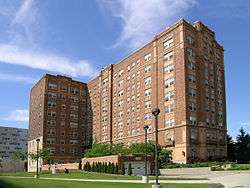

.svg.png)